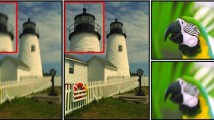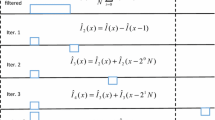Abstract
Data acquisition errors due to dead pixels or other hardware defects can cause undesirable artifacts in imaging applications. Compensating for these defects typically requires knowledge such as a defective pixel map, which can be difficult or costly to obtain and which is not necessarily static. However, recent calibration data is readily available in many applications. In this paper, we compute optimal filters for image deconvolution with denoising using only this calibration data, by minimizing the empirical Bayes risk. We derive a bound on how the reconstruction changes as the number of dead pixels grows. We show that our approach is able to reconstruct missing information better than standard filtering approaches and is robust even in the presence of a large number of defects and to defects that arise after calibration.







Similar content being viewed by others
Notes
The extension to a matrix A that has more rows than columns, or that has rank less than n, is straightforward. In that case, replace every Σ −1 by the pseudo-inverse Σ † and every summation from i=1 to n by a summation i=1 to \(\operatorname {rank} ( \mathbf{A} )\), so that the number of filter factors is reduced to \(\operatorname {rank} (\mathbf{A} )\).
Any type of blurring operator A (spatially variant or invariant) may be considered, with the only restriction that the singular value decomposition should be available.
References
Barrett, J.F., Keat, N.: Artifacts in CT: recognition and avoidance. Radiographics 24, 1679–1691 (2004). doi:10.1148/rg.246045065
Bertalmio, M., Sapiro, G., Caselles, V., Ballester, C.: Image inpainting. In: SIGGRAPH’00 Proceedings of the 27th Annual Conference on Computer Graphics and Interactive Technique, pp. 417–424. ACM, New York (2000). doi:10.1145/344779.344972
Bushberg, J.T., Seibert, J.A., Leidholdt, E.M. Jr., Boone, J.M.: The Essential Physics of Medical Imaging, 2nd edn. Lippincott Williams & Wilkins, Philadelphia (2002)
Chan, T., Kang, S.: Error analysis for image inpainting. J. Math. Imaging Vis. 26(1–2), 85–103 (2006). doi:10.1007/s10851-006-6865-7
Chan, T., Shen, J.: Image Processing and Analysis: Variational, PDE, Wavelet, and Stochastic Methods. SIAM, Philadelphia (2005)
Chan, T., Yip, A., Park, F.: Simultaneous total variation image inpainting and blind deconvolution. Int. J. Imaging Syst. Technol. 15(1), 92–102 (2005). doi:10.1002/ima.20041
Chung, J., Chung, M., O’Leary, D.P.: Designing optimal spectral filters for inverse problems. SIAM J. Sci. Comput. 33(6), 3132–3252 (2011). doi:10.1137/100812938
Dahl, J., Hansen, P., Jensen, S., Jensen, T.: Algorithms and software for total variation image reconstruction via first-order methods. Numer. Algorithms 53(1), 67–92 (2010). doi:10.1007/s11075-009-9310-3
Daubechies, I.: Ten Lectures on Wavelets. CBMS-NSF Regional Conference Series in Applied Mathematics, vol. 61. SIAM, Philadelphia (1992)
De Vito, E., Rosasco, L., Caponnetto, A., De Giovannini, U., Odone, F.: Learning from examples as an inverse problem. J. Mach. Learn. Res. 6, 883–904 (2005)
Golub, G., Heath, M., Wahba, G.: Generalized cross-validation as a method for choosing a good ridge parameter. Technometrics 21(2), 215–223 (1979)
Golub, G., Pereyra, V.: The differentiation of pseudo-inverses and nonlinear least squares problems whose variables separate. SIAM J. Numer. Anal. 10(2), 413–432 (1973)
Golub, G.H., Pereyra, V.: Separable nonlinear least squares: the variable projection method and its applications. Inverse Probl. 19(2), R1–R26 (2003). doi:10.1088/0266-5611/19/2/201
Hainaut, O.: Basic image processing (1996). http://www.eso.org/~ohainaut/ccd
Hansen, P.C., Nagy, J., O’Leary, D.P.: Deblurring Images: Matrices, Spectra, and Filtering. SIAM, Philadelphia (2006)
Neelamani, R., Choi, H., Baraniuk, R.: ForWaRD: Fourier-wavelet regularized deconvolution for ill-conditioned systems. IEEE Trans. Signal Process. 52(2), 418–433 (2004)
Nocedal, J., Wright, S.: Numerical Optimization. Springer, New York (1999)
Nowak, R., Thul, M.: Wavelet-vaguelette restoration in photon-limited imaging. In: Proceedings of the 1998 IEEE International Conference on Acoustics, Speech and Signal Processing, 1998, vol. 5, pp. 2869–2872. IEEE Comput. Soc., Los Alamitos (1998). doi:10.1109/ICASSP.1998.678124
Pusey, E., Lufkin, R., Brown, R., Solomon, M., Stark, D., Tarr, R., Hanafee, W.: Magnetic resonance imaging artifacts: mechanism and clinical significance. Radiographics 6(5), 891–911 (1986)
Raven, C.: Numerical removal of ring artifacts in microtomography. Rev. Sci. Instrum. 69(8), 2978–2980 (1998). doi:10.1063/1.1149043
Vapnik, V.N.: Statistical Learning Theory. Wiley, New York (1998)
Whitmore, B., Wiggs, M.: Charge transfer traps in the WFPC2. In: Koratkar, A., Leitherer, C. (eds.) Calibrating HST: Post Servicing Mission, STScI Calibration Workshop 1, Conf. Proceedings. Space Telescope Science Institute, Baltimore (1995). http://www.stsci.edu/hst/wfpc2/documents/isr/9503_1.html
Acknowledgements
We are grateful to the referees for helpful suggestions. The work of J.C. was partially supported by NSF grant DMS 0902322. The work of D.P.O. was partially supported by NSF grant DMS 1016266. The satellite images were obtained from NASA’s website: www.nasa.gov.
Author information
Authors and Affiliations
Corresponding author
Rights and permissions
About this article
Cite this article
Chung, J., Chung, M. & O’Leary, D.P. Optimal Filters from Calibration Data for Image Deconvolution with Data Acquisition Error. J Math Imaging Vis 44, 366–374 (2012). https://doi.org/10.1007/s10851-012-0332-4
Published:
Issue Date:
DOI: https://doi.org/10.1007/s10851-012-0332-4




